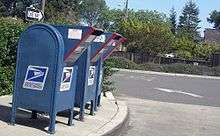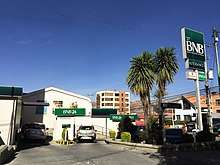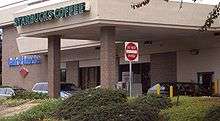Drive-through
A drive-through or drive-thru (a sensational spelling of the word through), is a type of take-out service provided by a business that allows customers to purchase products without leaving their cars. The format was pioneered in the United States in the 1930s by Jordan Martin,[1] but has since spread to other countries. The first recorded use of a bank using a drive-up window teller was the Grand National Bank of St. Louis, Missouri in 1930. The drive-up teller allowed only deposits at that time.[2]
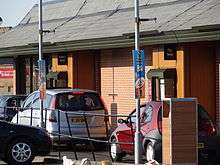
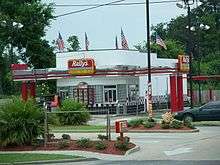
Orders are generally placed using a microphone and picked up in person at the window. A drive-through is different from a drive-in in several ways - the cars create a line and move in one direction in drive-throughs, and normally do not park, whereas drive-ins allow cars to park next to each other, the food is generally brought to the window by a server, called a carhop, and the customer can remain in the parked car to eat. However, during peak periods, to keep the queue down and avoid traffic flow problems, drive-throughs occasionally switch to an "order at the window, then park in a designated space" model where the customer will receive their food from an attendant when it is ready to be served. This results in a perceived relationship between the two service models.
Drive-throughs have generally replaced drive-ins in popular culture, and are now found in the vast majority of modern American fast-food chains. Sometimes, a store with a drive-through is referred to as a "drive-through", or the term is attached to the service, such as, "drive-through restaurant". or "drive-through bank".
Drive-throughs typically have signs over the drive-through lanes to show customers which lanes are open for business. The types of signage used is usually illuminated so the "open" message can be changed to a "closed" message when the lane is not available.
Drive-through restaurants
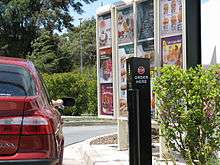
A drive-through restaurant generally consists of:
- A speaker and microphone for customers to place their orders
- A speaker and microphone or wireless headset system for employees to hear the customer's order (when a speaker is used)
- A trigger pad beneath the concrete to activate the microphone and headset, possibly augmented with a CCTV camera
- One or more free-standing signs listing the menu items, called a menu board
- Newer drive-throughs feature a LCD or LED display within the speaker system in order to show the full order and total cost to avert order errors through miscommunication. At many brands of restaurants, a secondary display featuring the total is placed directly next to the order window. This is to ensure that the customer will know if the cashier intentionally overcharges them.
- Windows where employees interact with customers by processing the customer's payment and giving them their order. Most drive-throughs have either one window serving both functions, or two windows with the first being used for payment and the second used for retrieving the order.
- Most restaurants have marked parking spaces just beyond the last window. If there is a significant delay in an individual customer's order (e.g. a special order), an employee may direct that customer to park in this area, clearing the drive-through lane for the next customer and preventing knock-on delays to other customers. When the order is ready, an employee hand-delivers the order to the customer. This service therefore occasionally has some similarities to drive-in service, but only during peak periods.
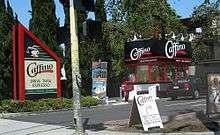
Drive-through designs are different from restaurant to restaurant; however, most drive-throughs can accommodate four to six passenger cars or trucks at once (called the queue). Most drive-through lanes are designed so the service windows and speaker are on the driver's side of the car, for example, in left-hand traffic (right-hand drive) countries such as the UK, Ireland, Australia, India and New Zealand, the windows will be on the right side of the drive-through lane, and vice versa in right-hand traffic (left-hand drive) countries such as North America and mainland Europe. There are a few drive-through lanes designed with the service windows on the passenger side, but these lanes are disfavored as they cannot be used easily by cars with only a driver.
History
In 1921, Kirby's Pig Stand introduced the drive-in restaurant, in which carhops delivered meals. In 1931, a California Pig Stand franchise introduced a drive-through service that bypassed the carhops. By the 1970s, drive-through service had replaced drive-in restaurants in the United States.[3]
The first McDonald's drive-through was created in 1975 in Sierra Vista, Arizona, near Fort Huachuca, a military installation, to serve military members who were not permitted to get out of their cars off-post while wearing fatigues.[4] The original McDonald's was closed down and demolished in May 1999 and a new McDonald's replaced it.
In 1981, Max Hamburgers opened Northern Europe's first drive-in in Piteå.[5]
The first drive-through restaurant in Europe, a McDonald's drive-through, opened at the Nutgrove Shopping Centre in Dublin, Ireland in 1985.[6]
In the US, drive-throughs account for 70 percent of McDonald's business and the average drive through order is fulfilled in under three and one half minutes.[7] Outside of the US, McDonald's drive-throughs are variously known as "McAuto", "McDrive" and "AutoMac".
In 2010, the Casa Linda, Texas, franchise of McDonald's opened a drive-through/walk-up only store with no indoor seating although it has a small patio with tables.[8]
In McDonald's in the UK, all McDonald's are going under an EOTF transformation (Experience of the Future), where all McDonald's with Drive-Thru's will have a third window. This would be where at the second window, the presenter would tell customers to pull up to the third window (if they've got a larger order and have longer to wait), this is known as the "fast forward window". This reduces waiting times for customers.
Drive-through banking
In 1928, City Center Bank, which became UMB Financial Corporation, president R. Crosby Kemper opened what is considered the first drive-up window. Shortly after the Grand National Bank in St Louis opened up a drive-through, including a slot to the side for night time deposits.[9] Westminster Bank opened the UK's first drive-through bank in Liverpool in 1959, soon followed by Ulster Bank opening Ireland's first in 1961 at Finaghy.[10]
In recent years, there has been a decline in drive-through banking due to increased traffic congestion and the increased availability of automated teller machines and telephone and internet banking. However, many bank buildings now feature drive-through ATMs.
Drive-through grocery shopping
Harold Willis and his father, Robert Willis, first incorporated a dairy and eggs drive through service in Redlands, California, in the early 1940s, supplying milk and eggs quickly and efficiently to driving customers; this utilized a dairy conveyor belt that Harold Willis had invented.[11] Some supermarkets offer drive-through facilities for grocery shopping. In the UK, this service was first announced by Tesco in August 2010.[12] And in the United States, Crafty's Drive-Buy Grocery Store in Virginia started offering the service. In 2012, the Dutch chain Albert Heijn introduced a "Pick Up Point" where one can collect groceries bought online.[13]
Other examples
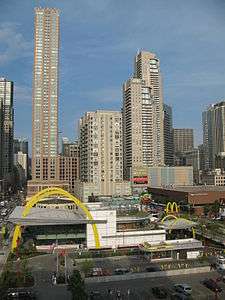
- Alcoholic beverages at a drive-through liquor store (called a "Beer Through", a "Cruise Through", a "Brew Thru" in the U.S. eastern Mid-Atlantic coast,[14] or a "Pony Keg" in certain areas; generally illegal in the Northeast and West)
- Postal services at a drive-through mailbox
- Coffee at a drive-through coffee shop
- Dairy products at a drive-through dairy store (notably the Skinner Dairy shops of North-East Florida or Dairy Barn in Long Island)
- Prescriptions at a drive-through pharmacy
- Marriage (primarily at special drive-through marriage chapels in Las Vegas in the United States)
- Funeral home where mourners can drive by, view and make offerings to the remains of their loved ones through windows.[15][16]
- Pennsylvania State Representative Kevin P. Murphy installed a drive-through window designed to speed constituent service.[17]
- Photo processing at Fotomat.
- In 2020, drive-through testing facilities were set up in many countries to test whether passengers were infected with COVID-19 (the first being in South Korea).[18]
Non-car usage
Pedestrian
Pedestrians sometimes attempt to walk through the drive-through to order food after the seated section of a fast-food restaurant has closed. Many establishments refuse drive-through service to pedestrians for safety, insurance, and liability reasons.[19] Cyclists are usually refused service with the same justification given.[20] However, in the summer of 2009, Burgerville gave use of the drive-through window to bicyclists.[21] Similar issues can arise in rural areas for people on horseback or in a horse-drawn carriage.[22]
On 20 July 2013, a woman was fined for taking her horse inside a McDonald's restaurant in Greater Manchester, United Kingdom after being refused service at the drive-through. The horse ended up defecating inside the restaurant which caused distress to other customers.[23]
In May 2016, Scott McGee filed a United States federal class action lawsuit pursuing action against McDonald's due to the company being unwilling to serve people who are visually impaired when only the drive thru lane is open.[24] As of October 2018, the matter is still in litigation.
On May 24, 2018, a law came into effect in Portland Oregon requiring multi-modal access to drive-throughs.[25] The new zoning law states, "When a drive-through facility is open and other pedestrian-oriented customer entrances to the business are unavailable or locked, the drive-through facility must serve customers using modes other than a vehicle such as pedestrians and bicyclists."[26]
Walk-up windows
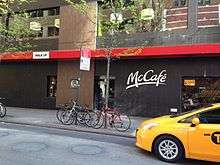
Some establishments provide a walk-up window instead when a drive-through may not be practical. However, the walk-up windows should not be confused with small establishments that customers are lined up for services such as mobile kitchens, kiosks or concession stands. These walk-up windows are value-added services on top of the full services provided inside the stores.[27]
The walk-up windows generally provide similar customer experience with the drive-throughs by allowing customers to receive services from the exterior of the facilities through a window. There are many reasons for the owners to provide such services. An example is when McDonald's entered a new market in Russia where the majority of families did not own cars, the owners developed the walk-up windows as an alternative.[28] Another reason is to have a drive-through experience in the locations that are not feasible to construct a drive-through lane such as in city centers. Some establishments may want to use walk-up windows to attract certain customer demographics such as younger customers who need quick service during late night.[27] Another reason is to offer extended service hours and maintain a safe environment for employees, such as a bulletproof walk-up window in high-crime areas.[29]
Ski-through
McDonald's first opened a ski-through called McSki in the ski resort of Lindvallen, Sweden in 1996.[30]
References
- Robert J. Sickels (ed), The 1940s, Greenwood Press, 2004, p. 107.
- "Popular Mechanics". Books.google.com. Hearst Magazines. July 1930. p. 13. Retrieved 2016-06-02.
- Witzel, Michael Karl (2013). The Oxford Encyclopedia of Food and Drink in America. Oxford University Press. pp. 654–655. ISBN 978-0-19-973496-2.
- "Our History". McDonalds.com. 2010-10-01. Retrieved 2013-01-27.
- "History | Max". Maxarabia.com. 2015-10-23. Retrieved 2016-06-02.
- "Archived copy". Archived from the original on September 26, 2010. Retrieved June 6, 2009.CS1 maint: archived copy as title (link)
- Purdy, Chase (20 June 2017). "Americans won't wait more than four minutes for a slightly less disgusting hamburger". Quartz (publication). Retrieved 20 June 2017.
- "Casa Linda - Casa Linda". Mctexas.com. Archived from the original on 2013-01-28. Retrieved 2013-01-27.
- "Popular Mechanics". Books.google.com. Hearst Magazines. July 1930. p. 13. Retrieved 2016-06-02.
- "Ulster Bank - drive through banking". 2008-06-23. Archived from the original on June 23, 2008. Retrieved 2016-06-02.CS1 maint: unfit url (link)
- "Obituary for Harold Wendt Willis - REDLANDS, CA". www.emmersonbartlett.com. Retrieved 2016-01-26.
- "Click and collect, the new way to beat the queues at Tesco: Britain's first supermarket drive-thru opens for business". Daily Mail. 24 August 2010. Retrieved 29 October 2012.
- "Albert Heijn Pick Up Point". YouTube. 2012-10-31. Retrieved 2016-06-02.
- "Soda or Pop? Maps Show Americans' Colorful Dialect Differences - DiscoverMagazine.com". discovermagazine.com.
- Hendin, David (1973). Death as a Fact of Life. New York, NY: W. W. Norton & Company, Inc. p. 221. ISBN 0-393-08540-6.
- "Nagano drive-thru funeral home to serve mourners with limited mobility". Kyodo News Agency. Japan Times. 16 December 2017. Retrieved 26 December 2017.
- "Want fries with that legislative help?". Pittsburgh Post Gazette. PG Publishing Co. Associated Press. 2009-04-18. Archived from the original on May 5, 2009.
- Bicker, Laura (12 March 2020). "Coronavirus in South Korea: How 'trace, test and treat' may be saving lives".
- See Chude v. Jack in the Box, 185 Cal. App. 4th 37 (2010). In this case, Jack in the Box successfully invoked the California Personal Responsibility Act of 1996 against an uninsured driver who spilled hot coffee on herself in the drive-through, then suffered second-degree burns because the wall of the restaurant prevented her from opening her car door and escaping the hot coffee on her car seat. Under the Act, plaintiff's lack of vehicle insurance barred her from recovering noneconomic damages, which form the bulk of damages in many U.S. personal injury cases. The Court of Appeal reasoned that the burn injury was reasonably related to the operation of a motor vehicle because Jack in the Box, in accordance with its strict policy, would not have served her if she had approached the drive-through window on foot; and because her injuries were exacerbated by the fact she was sitting in a car.
- "Archived copy". Archived from the original on July 9, 2006. Retrieved April 2, 2006.CS1 maint: archived copy as title (link)
- Rose, Joseph (August 13, 2009). "Burgerville to biking mom: No burgers for you!". Oregon Live. Retrieved August 28, 2011.
- "We don't do à la CART: McDonald's drive-thru refuses to serve woman in horse-drawn carriage... so she went to KFC". Daily Mail. May 26, 2011. Retrieved August 28, 2011.
- "Horse in McDonald's: Rider fined after 'drive-thru' refusal". BBC News. 2013-07-22. Retrieved 2016-06-02.
- "Blind man sues McDonald's for refusing drive-thru service". Usatoday.com. Retrieved 16 June 2016.
- Elise Herron (May 30, 2018). "It Is Now a Violation of Portland City Code For Drive-Thru Windows to Refuse to Serve People Who Pedal or Walk to the Window". Willamette Week. Retrieved October 19, 2018.
- "33.224 Drive-Through Facilities" (PDF), Portland Zoning Code, Bureau of Planning, City of Portland, Oregon, August 22, 2018 [1991], §33.224.070 Multi-Modal Access
- Luna, Taryn (19 December 2013). "McDonald's walk-up window to offer 24-hour service". Boston Globe. Retrieved 8 May 2014.
- Hoskisson, Michael A. Hitt, R. Duane Ireland, Robert E. (2013). Strategic management : competitiveness & globalization (10th ed.). Mason, OH: South-Western Cengage Learning. pp. 212–213. ISBN 978-1133495239.
- "ABC Board Shutters Calera Package Store "Drive-Through"". The Alabama Alcoholic Beverage Control Board (Press Release). 14 February 2014. Archived from the original on September 21, 2015. Retrieved 8 May 2014.
- "The 14 craziest McDonald's around the world".
External links
| Wikimedia Commons has media related to Drive-throughs. |
